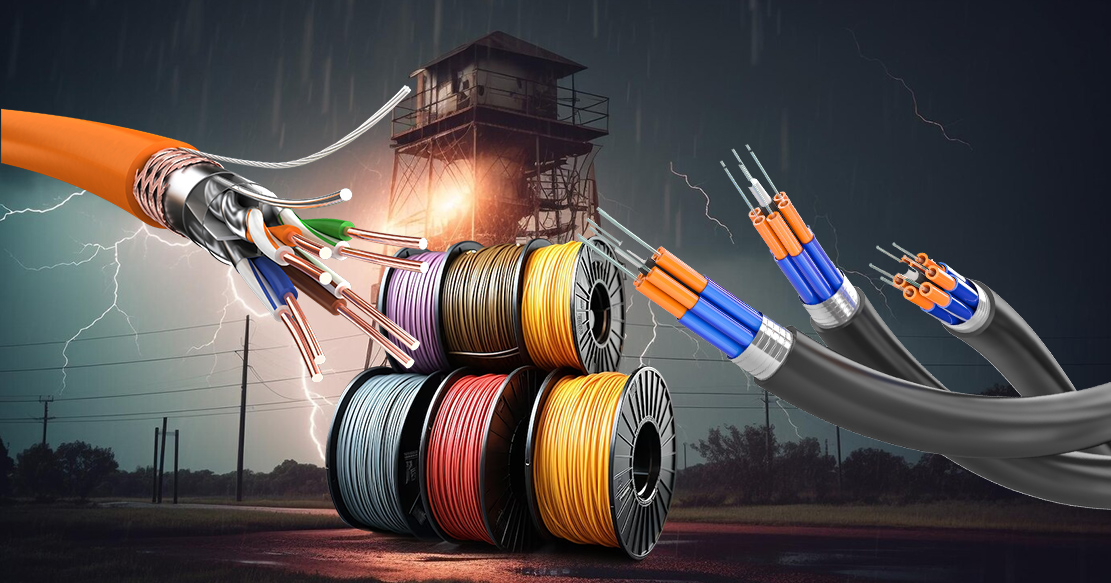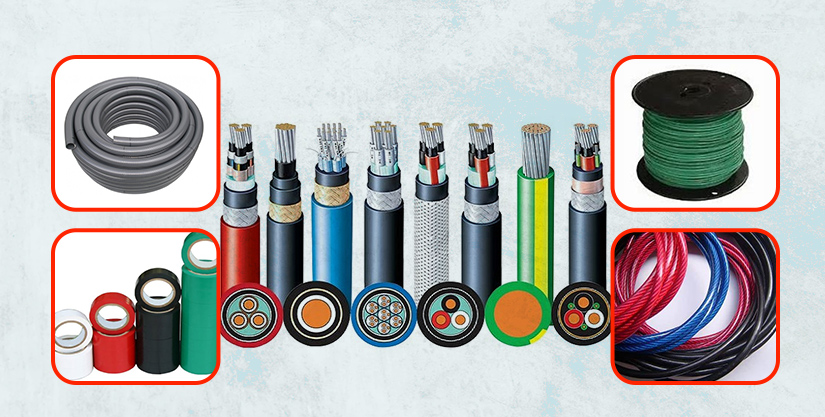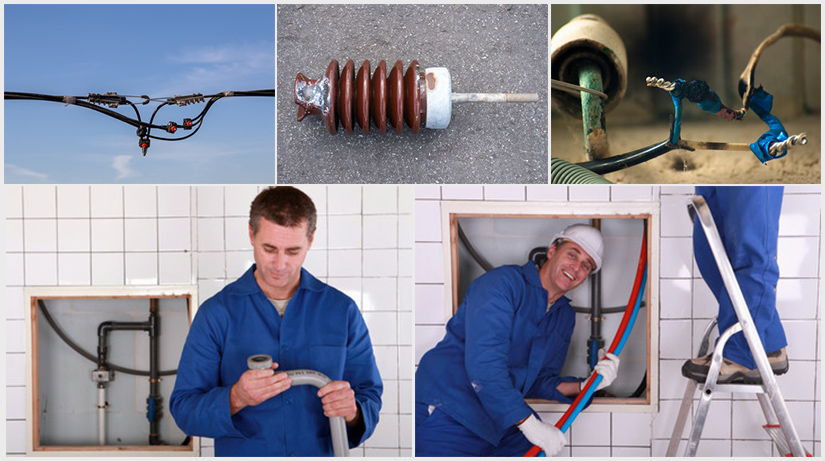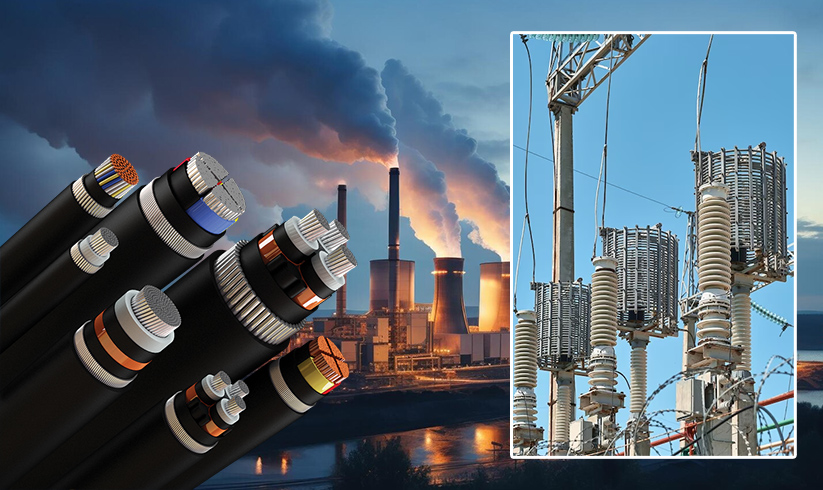
Insulation: Protection to Your Wire and Cables
Insulation is an essential component of an electrical wire and cable. It protects a cable’s integrity, prevents electrical damage, and enhances cable longevity.
Different insulation materials used for wire and cable include PVC, PE, PP, PUR, Rubber, and Fluoropolymers. The selection of insulation material depends on the cable’s temperature range and voltage rating, including stability, dielectric properties, etc.
Gloster Cable uses various insulation materials depending on the cable specification and usage.
Insulation and Reasons for Insulation
Insulation is a non-conductive material that surrounds and protects the individual wires and cables. It prevents conducting materials from touching each other, resists electrical leakage, and protects from the external environment. Insulation is crucial for the longevity of a wire and cable.
A few reasons for Wire and Cable Insulation are as follows.
 Chemicals
Chemicals
Wires and cables frequently get exposed to chemicals in many household applications and underground. It leads to corrosion. Insulation provides wires and cables resistance to chlorine, hydrogen gases, and other chemicals that lead to corrosion. We can use insulated wires in water and damp environments.
 Weather
Weather
Wires and cables perform at high temperatures in high-power applications or where wires are close to heat-emitting elements. Insulation protects against high temperature and wetness. Electrical insulation materials have good thermal properties that make cables withstand high temperatures.
 Flexibility
Flexibility
Cables getting frequently bent and flexed require insulation. It gives them freedom of motion and the ability to last long.
 Pressure
Pressure
Wires used underground need to sustain an incredible amount of pressure due to the weight of the earth above it. They need to maintain maximum pressure to get scummed to get crushed. Insulation of wires supports maintaining high pressure.
 Electrical Noise Reduction
Electrical Noise Reduction
Wires emit electromagnetic waves that can cause interference with nearby electronic devices or sensitive equipment. Insulation reduces the emission of these waves and provides shielding against external electromagnetic interference.
Various Types of Wire and Cable Insulation

Insulation of wires and cables is available in various varieties. The categories of wire insulation are plastics, fluoropolymers, and rubbers.
 Plastics
Plastics
Polyvinyl Chloride (PVC)
PVC is an expensive and easy-to-use material and can used in diverse applications. The temperature range of PVC insulation is -55°C to 105°C. It is flame retardant and moisture and abrasion-resistant. PVC insulated wire can hold up against gasoline, ozone, acids, and solvents. The insulation is safe for medical and food-related purposes and is odorless, tasteless, and non- toxic.
Semi-Rigid PVC (SR-PVC)SR-PVC is resistant to heat, water, acid, and alkali. It is also flame-retardant and very abrasion- resistant.
Plenum Polyvinyl Chloride (Plenum PVC)Plenum PVC is good for use in building spaces behind dropped ceilings or raised floors, which are left open for air circulation.
Polyethylene (PE)PE compound insulation is most common on coaxial and low capacitance cables and suitable for temperature ranges from -65°C to 80°C. It has exemplary electric qualities, although it is flammable. PE Insulation can reduce the dielectric constant. We can use it in cables requiring high-speed transmission. And when crosslinked, PE can produce high resistance to cracking, cut-through, soldering, and solvents.
Polyurethane (PUR)PUR is known for its extreme toughness and flexibility and is suitable for extremely low to high temperatures. It has excellent chemical, water, and abrasion resistance and works well in retractile cord applications, salt spray, and low-temperature military purposes.
Chlorinated Polyethylene (CPE)CPE insulation displays good heat, oil, and weather resistance. It is common in power and control cables and industrial power plant applications.
NylonNylon is a very flexible wire insulation and gets extruded over softer insulation compounds. It provides strong abrasion, cut-through, and chemical resistance.
 Fluoropolymers
Fluoropolymers
PFA
PFA has temperature ratings from 250°C to 65°C. The dissipation of PFA makes it an electrically efficient option, although being more expensive than other insulations.
PolytetrafluoroethylenePTFE can work under a wide range of temperatures from -73°C to 204°C. The insulation is resistant to water, oil, chemicals, and heat.
Fluorinated Ethylene Propylene (FEP)FEP is popular as insulation because of its processing characteristics and variety of applications. It is suitable for plenum cable and military applications.
Polyvinylidene Fluoride (PVDF)PVDF is also known as KYNAR. It gets used in various industries because of its low cost. PVDF insulation is flexible, lightweight, thermally stable, and resistant to chemical, heat, weather, abrasion, and fire.
Thermoplastic Elastomers (TPE)TPE includes polymers such as plastic and rubber. The application of insulation is for automotive and household applications. TPE-insulated wires and cables can get molded, extruded, and reused like plastic, maintaining rubber flexibility and stretch.
 Rubbers
Rubbers
The rubber insulation temperature range is wide. Its characteristics include low-temperature flexibility, water and alcohol resistance, electrical properties, and excellent abrasion resistance.
Thermoplastic Rubber (TPR)TPR replaces thermoset rubber with improved colorability, higher processing speeds, and a wide temperature range. It displays excellent heat, weather, and age resistance without curing.
NeopreneNeoprene exhibits supreme abrasion, cut-through, oil, and solvent resistance. It is flame retardant, self-extinguishing, and long service life.
Silicone, fiberglass, Ethylene propylene rubber, etc., are other rubbers used for application.
Insulation Breakdown Factors and Their Protection

Damage to the insulation layer of insulation of wires and cables occurs due to several factors, such as external damage and deterioration of insulation material. A few main reasons are
 Mechanical Damage
Mechanical Damage
Mechanical damage to the insulation can be due to heavy objects, bending of the cable, squeezing during shipment, the strong bottom layer of the buried cable, etc. We can avoid this mechanical cable insulation damage by using an overhead cable. If the cable gets laid along the wall, mark the ground and take soil near the cable line in time.
 Improper Construction
Improper Construction
Poor construction methods and material quality result in the breakdown of insulation. To prevent this, we need to improve installation quality. The insulation bag should be tight with no gap during the manufacture and installation of the cable head.
 Overvoltage
Overvoltage
Atmospheric overvoltage or internal overvoltage breaks the insulation layer. Lightning arresters improve the technical level of automatic system protection.
 Aging
Aging
The electrical and mechanical properties of insulation deteriorate in the long term due to heat dissipation or overload. The cable should be periodically tested for preventive voltage withstand.
An Appropriate Insulation Ensures Electrical Safety and Reliability

Gloster Cables, a top wire and cable manufacturer, offers various insulation types of wires and cables. At Gloster, the selection of insulation type depends on factors such as voltage rating, temperature range, flexibility requirements, environmental conditions, and others. Insulated wires and cables by Gloster bring numerous benefits, including enhanced safety and improved performance..
CONTACT US